Holmes Institute Accounting for Business: Financial Statement Analysis
VerifiedAdded on 2023/06/07
|6
|1433
|162
Homework Assignment
AI Summary
This assignment solution analyzes financial statements and key financial ratios to assess a company's performance. Part A focuses on calculating and interpreting current ratio, quick ratio, accounts receivable turnover, and inventory turnover for 2018 and 2019, evaluating short-term solvency and efficiency. Part B examines revenue recognition based on AASB 118, classifying various cash flows as revenue or income. Part C presents a scenario comparing two companies, XYZ and ABC, and provides recommendations on which company is more favorable for a loan and a higher purchase price, considering factors like capital structure and liabilities. The solution provides a detailed analysis of the financial health of businesses using accounting principles and financial ratios.

ACCOUNTING FOR BUSINESS
STUDENT ID:
[Pick the date]
STUDENT ID:
[Pick the date]
Paraphrase This Document
Need a fresh take? Get an instant paraphrase of this document with our AI Paraphraser
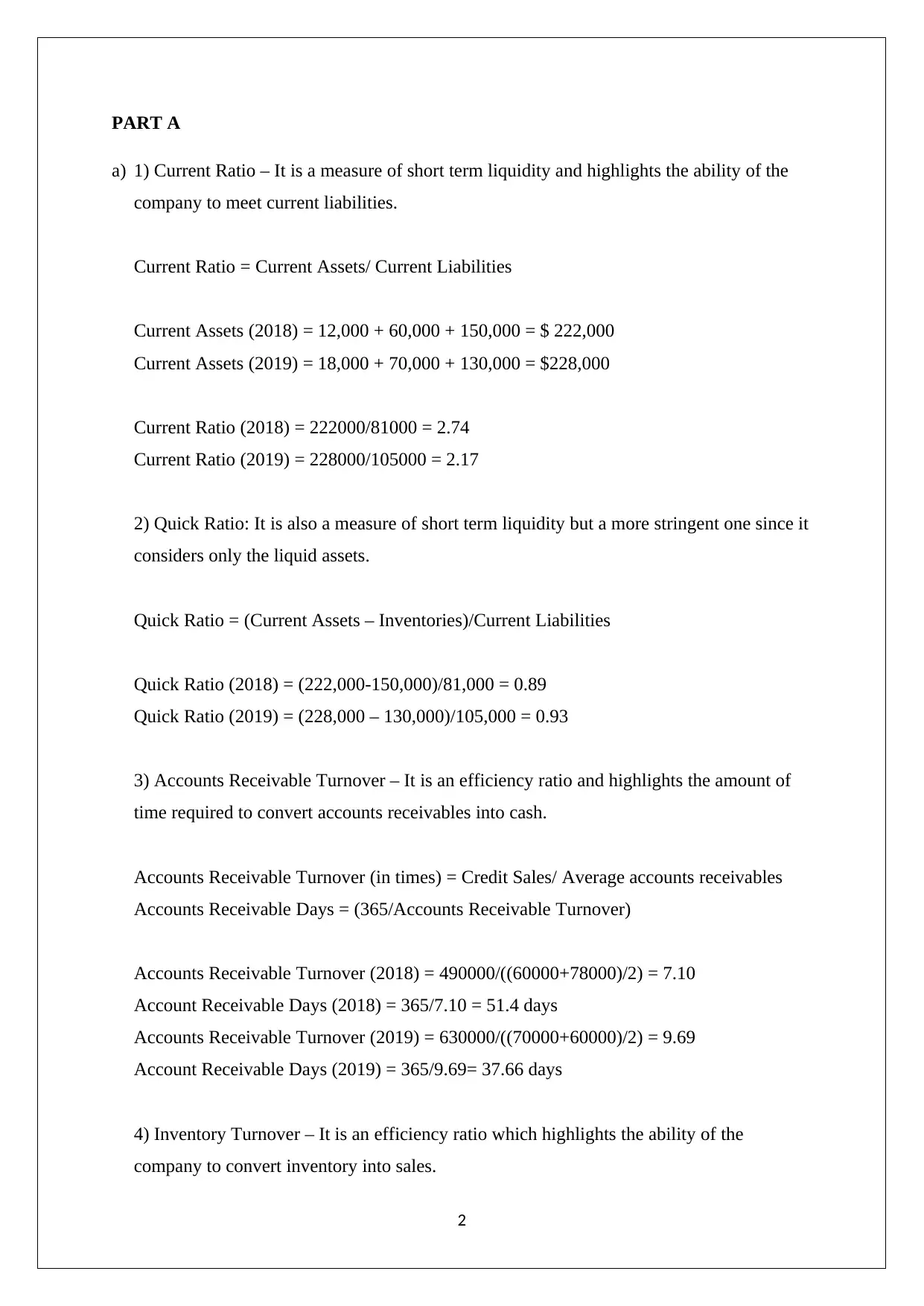
PART A
a) 1) Current Ratio – It is a measure of short term liquidity and highlights the ability of the
company to meet current liabilities.
Current Ratio = Current Assets/ Current Liabilities
Current Assets (2018) = 12,000 + 60,000 + 150,000 = $ 222,000
Current Assets (2019) = 18,000 + 70,000 + 130,000 = $228,000
Current Ratio (2018) = 222000/81000 = 2.74
Current Ratio (2019) = 228000/105000 = 2.17
2) Quick Ratio: It is also a measure of short term liquidity but a more stringent one since it
considers only the liquid assets.
Quick Ratio = (Current Assets – Inventories)/Current Liabilities
Quick Ratio (2018) = (222,000-150,000)/81,000 = 0.89
Quick Ratio (2019) = (228,000 – 130,000)/105,000 = 0.93
3) Accounts Receivable Turnover – It is an efficiency ratio and highlights the amount of
time required to convert accounts receivables into cash.
Accounts Receivable Turnover (in times) = Credit Sales/ Average accounts receivables
Accounts Receivable Days = (365/Accounts Receivable Turnover)
Accounts Receivable Turnover (2018) = 490000/((60000+78000)/2) = 7.10
Account Receivable Days (2018) = 365/7.10 = 51.4 days
Accounts Receivable Turnover (2019) = 630000/((70000+60000)/2) = 9.69
Account Receivable Days (2019) = 365/9.69= 37.66 days
4) Inventory Turnover – It is an efficiency ratio which highlights the ability of the
company to convert inventory into sales.
2
a) 1) Current Ratio – It is a measure of short term liquidity and highlights the ability of the
company to meet current liabilities.
Current Ratio = Current Assets/ Current Liabilities
Current Assets (2018) = 12,000 + 60,000 + 150,000 = $ 222,000
Current Assets (2019) = 18,000 + 70,000 + 130,000 = $228,000
Current Ratio (2018) = 222000/81000 = 2.74
Current Ratio (2019) = 228000/105000 = 2.17
2) Quick Ratio: It is also a measure of short term liquidity but a more stringent one since it
considers only the liquid assets.
Quick Ratio = (Current Assets – Inventories)/Current Liabilities
Quick Ratio (2018) = (222,000-150,000)/81,000 = 0.89
Quick Ratio (2019) = (228,000 – 130,000)/105,000 = 0.93
3) Accounts Receivable Turnover – It is an efficiency ratio and highlights the amount of
time required to convert accounts receivables into cash.
Accounts Receivable Turnover (in times) = Credit Sales/ Average accounts receivables
Accounts Receivable Days = (365/Accounts Receivable Turnover)
Accounts Receivable Turnover (2018) = 490000/((60000+78000)/2) = 7.10
Account Receivable Days (2018) = 365/7.10 = 51.4 days
Accounts Receivable Turnover (2019) = 630000/((70000+60000)/2) = 9.69
Account Receivable Days (2019) = 365/9.69= 37.66 days
4) Inventory Turnover – It is an efficiency ratio which highlights the ability of the
company to convert inventory into sales.
2
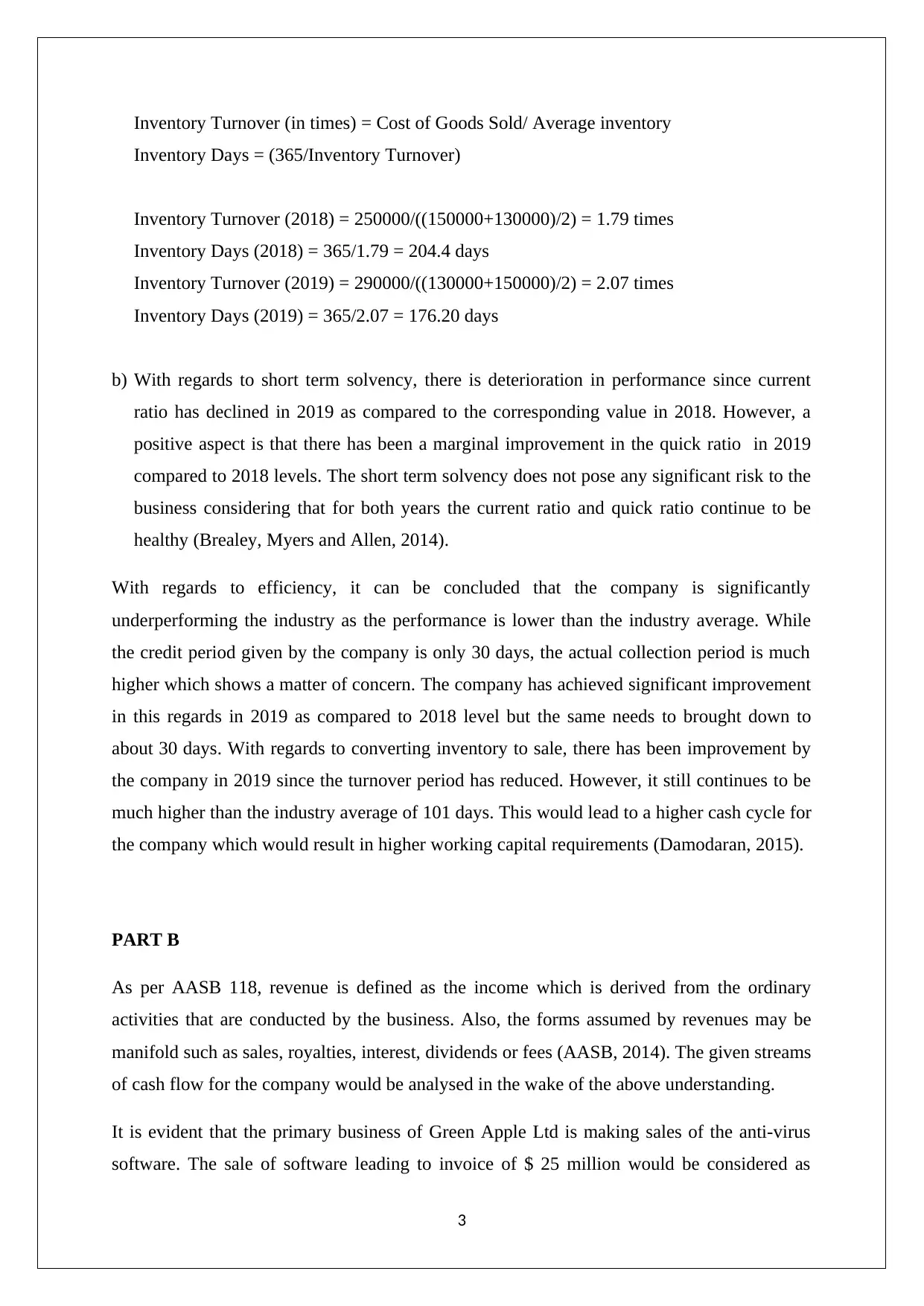
Inventory Turnover (in times) = Cost of Goods Sold/ Average inventory
Inventory Days = (365/Inventory Turnover)
Inventory Turnover (2018) = 250000/((150000+130000)/2) = 1.79 times
Inventory Days (2018) = 365/1.79 = 204.4 days
Inventory Turnover (2019) = 290000/((130000+150000)/2) = 2.07 times
Inventory Days (2019) = 365/2.07 = 176.20 days
b) With regards to short term solvency, there is deterioration in performance since current
ratio has declined in 2019 as compared to the corresponding value in 2018. However, a
positive aspect is that there has been a marginal improvement in the quick ratio in 2019
compared to 2018 levels. The short term solvency does not pose any significant risk to the
business considering that for both years the current ratio and quick ratio continue to be
healthy (Brealey, Myers and Allen, 2014).
With regards to efficiency, it can be concluded that the company is significantly
underperforming the industry as the performance is lower than the industry average. While
the credit period given by the company is only 30 days, the actual collection period is much
higher which shows a matter of concern. The company has achieved significant improvement
in this regards in 2019 as compared to 2018 level but the same needs to brought down to
about 30 days. With regards to converting inventory to sale, there has been improvement by
the company in 2019 since the turnover period has reduced. However, it still continues to be
much higher than the industry average of 101 days. This would lead to a higher cash cycle for
the company which would result in higher working capital requirements (Damodaran, 2015).
PART B
As per AASB 118, revenue is defined as the income which is derived from the ordinary
activities that are conducted by the business. Also, the forms assumed by revenues may be
manifold such as sales, royalties, interest, dividends or fees (AASB, 2014). The given streams
of cash flow for the company would be analysed in the wake of the above understanding.
It is evident that the primary business of Green Apple Ltd is making sales of the anti-virus
software. The sale of software leading to invoice of $ 25 million would be considered as
3
Inventory Days = (365/Inventory Turnover)
Inventory Turnover (2018) = 250000/((150000+130000)/2) = 1.79 times
Inventory Days (2018) = 365/1.79 = 204.4 days
Inventory Turnover (2019) = 290000/((130000+150000)/2) = 2.07 times
Inventory Days (2019) = 365/2.07 = 176.20 days
b) With regards to short term solvency, there is deterioration in performance since current
ratio has declined in 2019 as compared to the corresponding value in 2018. However, a
positive aspect is that there has been a marginal improvement in the quick ratio in 2019
compared to 2018 levels. The short term solvency does not pose any significant risk to the
business considering that for both years the current ratio and quick ratio continue to be
healthy (Brealey, Myers and Allen, 2014).
With regards to efficiency, it can be concluded that the company is significantly
underperforming the industry as the performance is lower than the industry average. While
the credit period given by the company is only 30 days, the actual collection period is much
higher which shows a matter of concern. The company has achieved significant improvement
in this regards in 2019 as compared to 2018 level but the same needs to brought down to
about 30 days. With regards to converting inventory to sale, there has been improvement by
the company in 2019 since the turnover period has reduced. However, it still continues to be
much higher than the industry average of 101 days. This would lead to a higher cash cycle for
the company which would result in higher working capital requirements (Damodaran, 2015).
PART B
As per AASB 118, revenue is defined as the income which is derived from the ordinary
activities that are conducted by the business. Also, the forms assumed by revenues may be
manifold such as sales, royalties, interest, dividends or fees (AASB, 2014). The given streams
of cash flow for the company would be analysed in the wake of the above understanding.
It is evident that the primary business of Green Apple Ltd is making sales of the anti-virus
software. The sale of software leading to invoice of $ 25 million would be considered as
3
⊘ This is a preview!⊘
Do you want full access?
Subscribe today to unlock all pages.

Trusted by 1+ million students worldwide
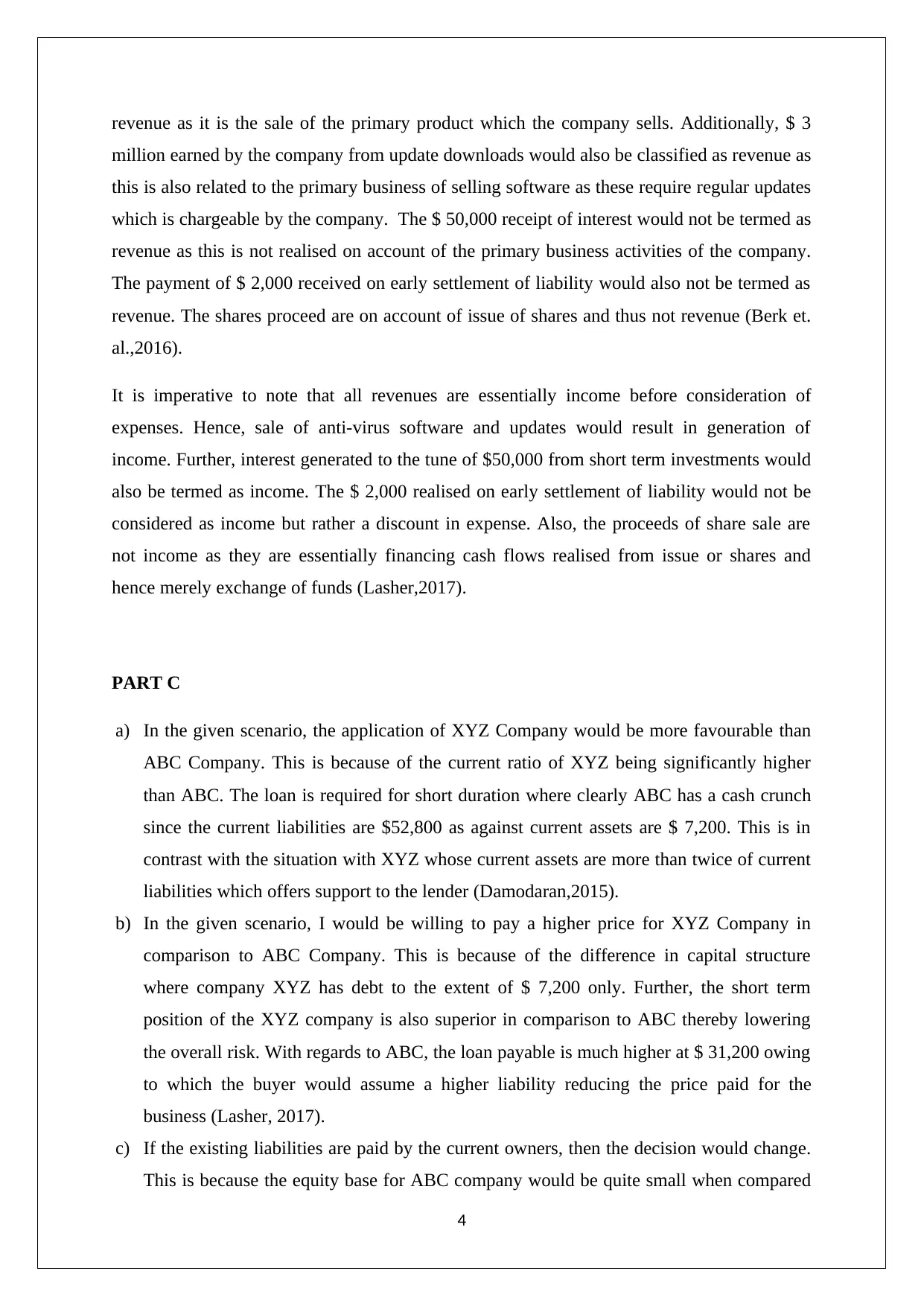
revenue as it is the sale of the primary product which the company sells. Additionally, $ 3
million earned by the company from update downloads would also be classified as revenue as
this is also related to the primary business of selling software as these require regular updates
which is chargeable by the company. The $ 50,000 receipt of interest would not be termed as
revenue as this is not realised on account of the primary business activities of the company.
The payment of $ 2,000 received on early settlement of liability would also not be termed as
revenue. The shares proceed are on account of issue of shares and thus not revenue (Berk et.
al.,2016).
It is imperative to note that all revenues are essentially income before consideration of
expenses. Hence, sale of anti-virus software and updates would result in generation of
income. Further, interest generated to the tune of $50,000 from short term investments would
also be termed as income. The $ 2,000 realised on early settlement of liability would not be
considered as income but rather a discount in expense. Also, the proceeds of share sale are
not income as they are essentially financing cash flows realised from issue or shares and
hence merely exchange of funds (Lasher,2017).
PART C
a) In the given scenario, the application of XYZ Company would be more favourable than
ABC Company. This is because of the current ratio of XYZ being significantly higher
than ABC. The loan is required for short duration where clearly ABC has a cash crunch
since the current liabilities are $52,800 as against current assets are $ 7,200. This is in
contrast with the situation with XYZ whose current assets are more than twice of current
liabilities which offers support to the lender (Damodaran,2015).
b) In the given scenario, I would be willing to pay a higher price for XYZ Company in
comparison to ABC Company. This is because of the difference in capital structure
where company XYZ has debt to the extent of $ 7,200 only. Further, the short term
position of the XYZ company is also superior in comparison to ABC thereby lowering
the overall risk. With regards to ABC, the loan payable is much higher at $ 31,200 owing
to which the buyer would assume a higher liability reducing the price paid for the
business (Lasher, 2017).
c) If the existing liabilities are paid by the current owners, then the decision would change.
This is because the equity base for ABC company would be quite small when compared
4
million earned by the company from update downloads would also be classified as revenue as
this is also related to the primary business of selling software as these require regular updates
which is chargeable by the company. The $ 50,000 receipt of interest would not be termed as
revenue as this is not realised on account of the primary business activities of the company.
The payment of $ 2,000 received on early settlement of liability would also not be termed as
revenue. The shares proceed are on account of issue of shares and thus not revenue (Berk et.
al.,2016).
It is imperative to note that all revenues are essentially income before consideration of
expenses. Hence, sale of anti-virus software and updates would result in generation of
income. Further, interest generated to the tune of $50,000 from short term investments would
also be termed as income. The $ 2,000 realised on early settlement of liability would not be
considered as income but rather a discount in expense. Also, the proceeds of share sale are
not income as they are essentially financing cash flows realised from issue or shares and
hence merely exchange of funds (Lasher,2017).
PART C
a) In the given scenario, the application of XYZ Company would be more favourable than
ABC Company. This is because of the current ratio of XYZ being significantly higher
than ABC. The loan is required for short duration where clearly ABC has a cash crunch
since the current liabilities are $52,800 as against current assets are $ 7,200. This is in
contrast with the situation with XYZ whose current assets are more than twice of current
liabilities which offers support to the lender (Damodaran,2015).
b) In the given scenario, I would be willing to pay a higher price for XYZ Company in
comparison to ABC Company. This is because of the difference in capital structure
where company XYZ has debt to the extent of $ 7,200 only. Further, the short term
position of the XYZ company is also superior in comparison to ABC thereby lowering
the overall risk. With regards to ABC, the loan payable is much higher at $ 31,200 owing
to which the buyer would assume a higher liability reducing the price paid for the
business (Lasher, 2017).
c) If the existing liabilities are paid by the current owners, then the decision would change.
This is because the equity base for ABC company would be quite small when compared
4
Paraphrase This Document
Need a fresh take? Get an instant paraphrase of this document with our AI Paraphraser
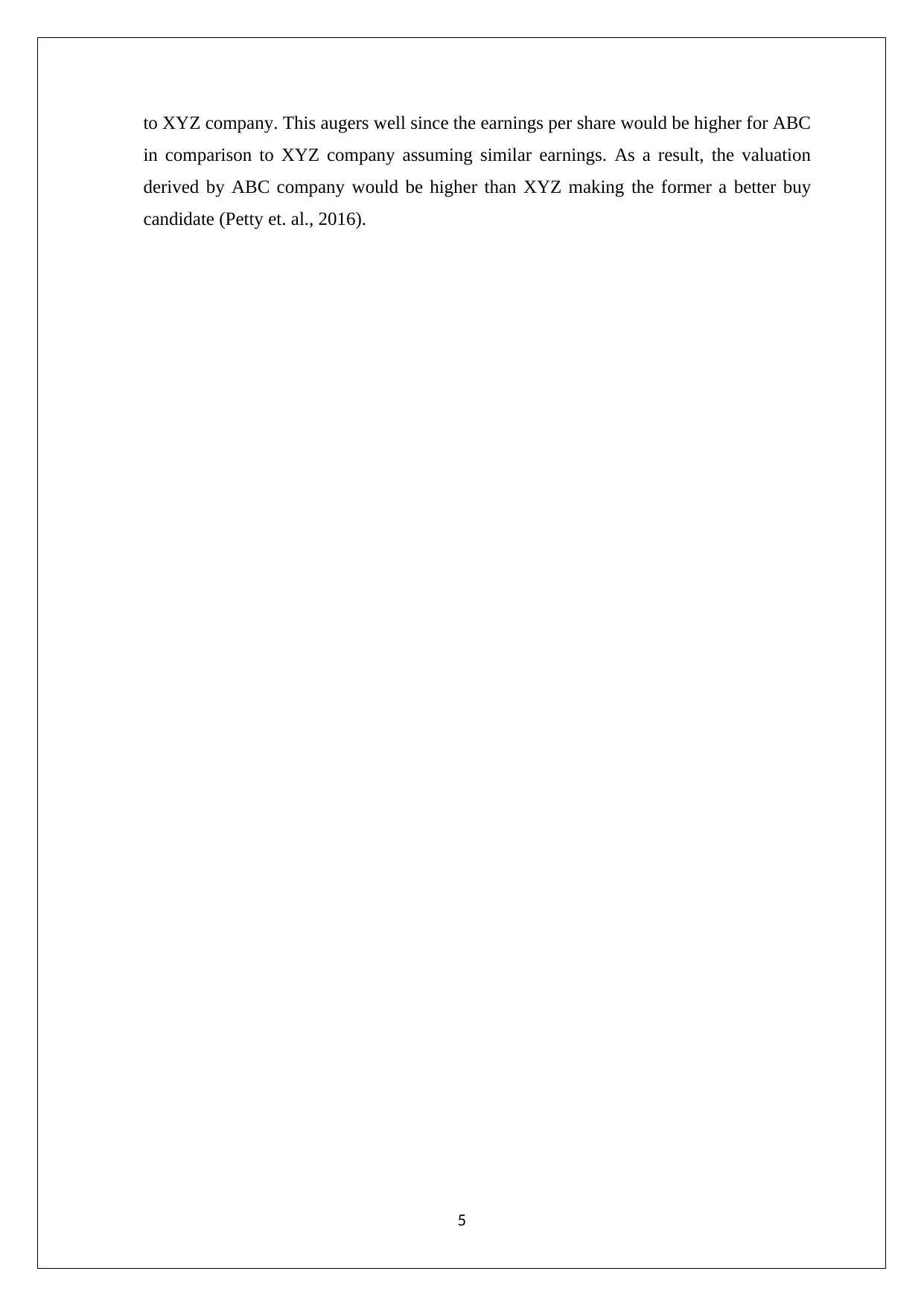
to XYZ company. This augers well since the earnings per share would be higher for ABC
in comparison to XYZ company assuming similar earnings. As a result, the valuation
derived by ABC company would be higher than XYZ making the former a better buy
candidate (Petty et. al., 2016).
5
in comparison to XYZ company assuming similar earnings. As a result, the valuation
derived by ABC company would be higher than XYZ making the former a better buy
candidate (Petty et. al., 2016).
5
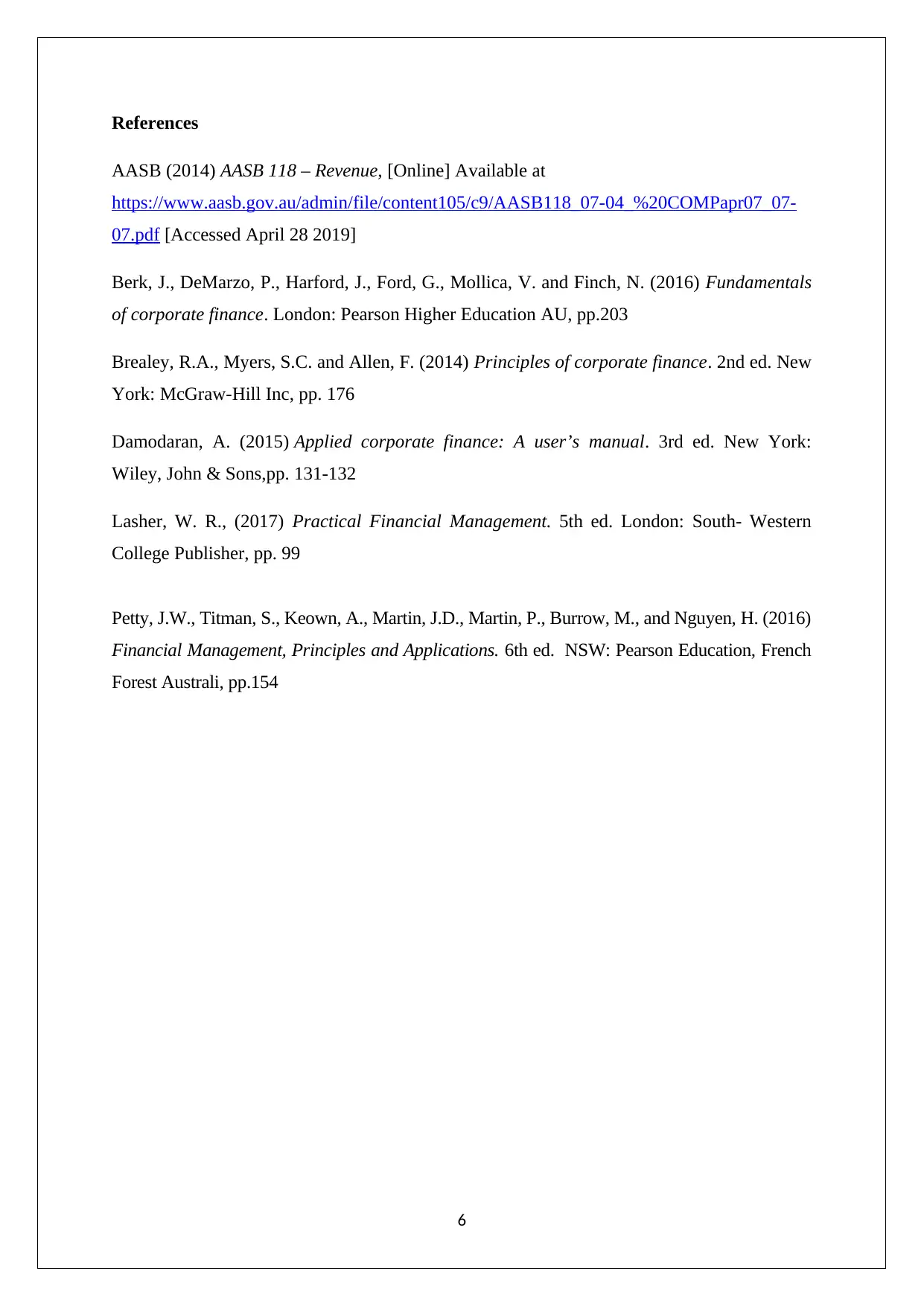
References
AASB (2014) AASB 118 – Revenue, [Online] Available at
https://www.aasb.gov.au/admin/file/content105/c9/AASB118_07-04_%20COMPapr07_07-
07.pdf [Accessed April 28 2019]
Berk, J., DeMarzo, P., Harford, J., Ford, G., Mollica, V. and Finch, N. (2016) Fundamentals
of corporate finance. London: Pearson Higher Education AU, pp.203
Brealey, R.A., Myers, S.C. and Allen, F. (2014) Principles of corporate finance. 2nd ed. New
York: McGraw-Hill Inc, pp. 176
Damodaran, A. (2015) Applied corporate finance: A user’s manual. 3rd ed. New York:
Wiley, John & Sons,pp. 131-132
Lasher, W. R., (2017) Practical Financial Management. 5th ed. London: South- Western
College Publisher, pp. 99
Petty, J.W., Titman, S., Keown, A., Martin, J.D., Martin, P., Burrow, M., and Nguyen, H. (2016)
Financial Management, Principles and Applications. 6th ed. NSW: Pearson Education, French
Forest Australi, pp.154
6
AASB (2014) AASB 118 – Revenue, [Online] Available at
https://www.aasb.gov.au/admin/file/content105/c9/AASB118_07-04_%20COMPapr07_07-
07.pdf [Accessed April 28 2019]
Berk, J., DeMarzo, P., Harford, J., Ford, G., Mollica, V. and Finch, N. (2016) Fundamentals
of corporate finance. London: Pearson Higher Education AU, pp.203
Brealey, R.A., Myers, S.C. and Allen, F. (2014) Principles of corporate finance. 2nd ed. New
York: McGraw-Hill Inc, pp. 176
Damodaran, A. (2015) Applied corporate finance: A user’s manual. 3rd ed. New York:
Wiley, John & Sons,pp. 131-132
Lasher, W. R., (2017) Practical Financial Management. 5th ed. London: South- Western
College Publisher, pp. 99
Petty, J.W., Titman, S., Keown, A., Martin, J.D., Martin, P., Burrow, M., and Nguyen, H. (2016)
Financial Management, Principles and Applications. 6th ed. NSW: Pearson Education, French
Forest Australi, pp.154
6
⊘ This is a preview!⊘
Do you want full access?
Subscribe today to unlock all pages.

Trusted by 1+ million students worldwide
1 out of 6
Related Documents
Your All-in-One AI-Powered Toolkit for Academic Success.
+13062052269
info@desklib.com
Available 24*7 on WhatsApp / Email
![[object Object]](/_next/static/media/star-bottom.7253800d.svg)
Unlock your academic potential
Copyright © 2020–2025 A2Z Services. All Rights Reserved. Developed and managed by ZUCOL.





